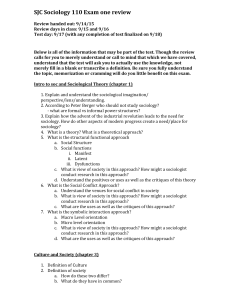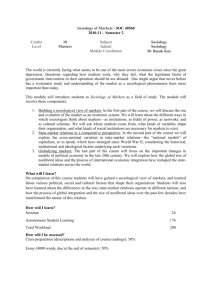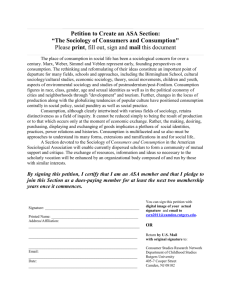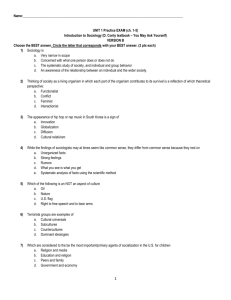Sociology of the Life Course (undergraduate)
advertisement
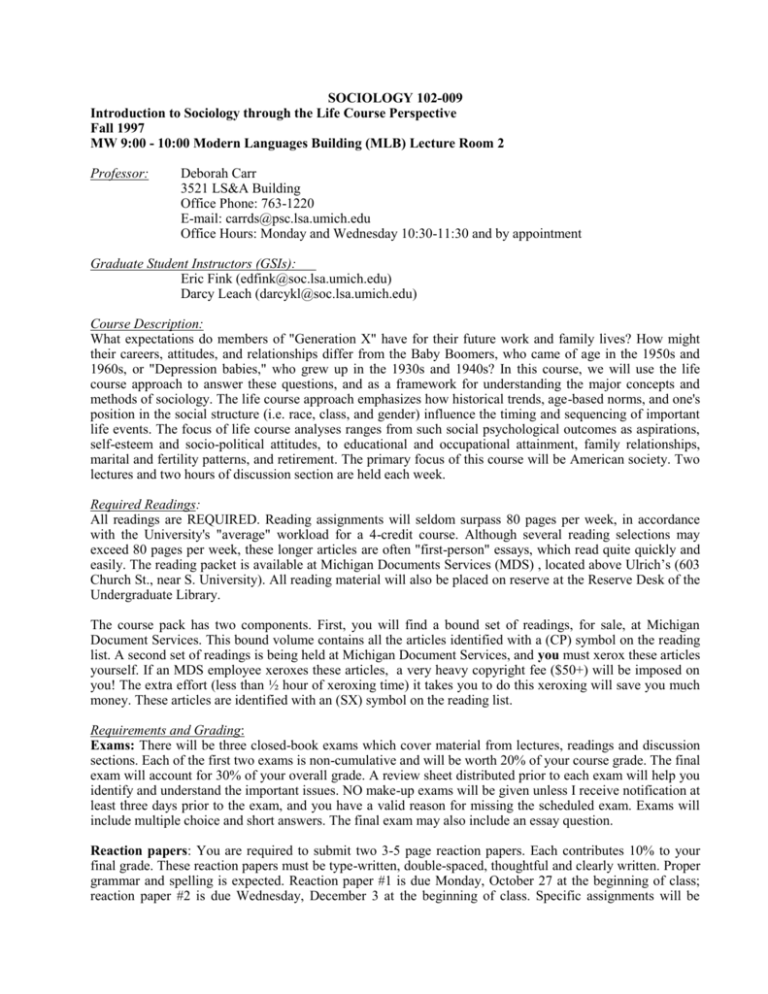
SOCIOLOGY 102-009 Introduction to Sociology through the Life Course Perspective Fall 1997 MW 9:00 - 10:00 Modern Languages Building (MLB) Lecture Room 2 Professor: Deborah Carr 3521 LS&A Building Office Phone: 763-1220 E-mail: carrds@psc.lsa.umich.edu Office Hours: Monday and Wednesday 10:30-11:30 and by appointment Graduate Student Instructors (GSIs): Eric Fink (edfink@soc.lsa.umich.edu) Darcy Leach (darcykl@soc.lsa.umich.edu) Course Description: What expectations do members of "Generation X" have for their future work and family lives? How might their careers, attitudes, and relationships differ from the Baby Boomers, who came of age in the 1950s and 1960s, or "Depression babies," who grew up in the 1930s and 1940s? In this course, we will use the life course approach to answer these questions, and as a framework for understanding the major concepts and methods of sociology. The life course approach emphasizes how historical trends, age-based norms, and one's position in the social structure (i.e. race, class, and gender) influence the timing and sequencing of important life events. The focus of life course analyses ranges from such social psychological outcomes as aspirations, self-esteem and socio-political attitudes, to educational and occupational attainment, family relationships, marital and fertility patterns, and retirement. The primary focus of this course will be American society. Two lectures and two hours of discussion section are held each week. Required Readings: All readings are REQUIRED. Reading assignments will seldom surpass 80 pages per week, in accordance with the University's "average" workload for a 4-credit course. Although several reading selections may exceed 80 pages per week, these longer articles are often "first-person" essays, which read quite quickly and easily. The reading packet is available at Michigan Documents Services (MDS) , located above Ulrich’s (603 Church St., near S. University). All reading material will also be placed on reserve at the Reserve Desk of the Undergraduate Library. The course pack has two components. First, you will find a bound set of readings, for sale, at Michigan Document Services. This bound volume contains all the articles identified with a (CP) symbol on the reading list. A second set of readings is being held at Michigan Document Services, and you must xerox these articles yourself. If an MDS employee xeroxes these articles, a very heavy copyright fee ($50+) will be imposed on you! The extra effort (less than ½ hour of xeroxing time) it takes you to do this xeroxing will save you much money. These articles are identified with an (SX) symbol on the reading list. Requirements and Grading: Exams: There will be three closed-book exams which cover material from lectures, readings and discussion sections. Each of the first two exams is non-cumulative and will be worth 20% of your course grade. The final exam will account for 30% of your overall grade. A review sheet distributed prior to each exam will help you identify and understand the important issues. NO make-up exams will be given unless I receive notification at least three days prior to the exam, and you have a valid reason for missing the scheduled exam. Exams will include multiple choice and short answers. The final exam may also include an essay question. Reaction papers: You are required to submit two 3-5 page reaction papers. Each contributes 10% to your final grade. These reaction papers must be type-written, double-spaced, thoughtful and clearly written. Proper grammar and spelling is expected. Reaction paper #1 is due Monday, October 27 at the beginning of class; reaction paper #2 is due Wednesday, December 3 at the beginning of class. Specific assignments will be handed out two weeks before the reaction paper due date. Comment papers: You are expected to hand in five short "comment papers" throughout the semester. These short (maximum length: one page) papers may include reactions to a reading in the course, a lecture or discussion section. You may do these any time during the semester, as long as you have completed five by the last class session (i.e. no later than 10 a.m., Monday December 15). These papers are not graded, but they will be read in order to make sure that you are reading and thinking about the assigned materials. Each paper is worth two points; the five papers combined account for 10% of your final grade. Class participation: Regular attendance at lectures and participation in discussion sections will be taken into account in calculating the final grade, especially in borderline cases. Extra credit option: We will cover a variety of thought-provoking topics in this course, and some of you may be inspired to do additional reading on a topic you find particularly compelling. You will have the opportunity to do an "extra credit" project, worth 0 to 3 points based on the quality of your work. These "extra credit" points will be added to your overall class average. You may write an 8-10 page research paper or critical essay on the topic of your choice. The topic must be approved by the professor by Oct. 15. The research paper should include a critical review and integration of relevant literature. In addition to adding "points" to your class grade, this assignment also affords you an opportunity to apply the life course perspective to your own major field of study. Extra-credit assignments may be handed in at any point during the semester, but any work received later than Friday December 12, 5 p.m. will NOT be accepted. Only typewritten papers will be accepted. Proper grammar and spelling is expected. Summary of grading procedure: Course grades are based on the total number of points an individual earns on exams, comment papers and reaction papers, relative to point totals earned by others in the class. "Extra credit" points will be added to the final grade, where applicable, after the overall course grade distribution is established. In determining course grades, the assignments are weighted as follows: Exam 1 [10/13/97] Exam 2 [11/10/97] 5 comment papers (2 points each) 2 reaction papers (10 points each) [10/27 & 12/3/97] Final exam [12/15/97] TOTAL 20% 20% 10% 20% 30% 100% SCHEDULE OF CLASSES AND READINGS I. INTRODUCTION TO SOCIOLOGY AND THE LIFE COURSE PERSPECTIVE A. What is Sociology ? W September 3. Welcome and Introduction to Sociology M September 8. What is Sociology? (CP) Henslin, James M. 1993. Down to Earth Sociology: Introductory Readings (7th edition). New York: The Free Press. Chapter 2 "Sociology and the Social Sciences" (Pp. 8-18). (CP) Mills, C. Wright [1959] 1992. "The Promise of Sociology." Pp. 11-17 in Contemporary Issues in Society, edited by Hugh F. Lena, W.B. Helmreich, and W. McCord. New York: McGraw-Hill. W September 10. Sociological Methods: How Do We Study People? (CP) Kammeyer, K.C.W., G. Ritzer, and N.R. Yetman. 1994. Sociology: Experiencing Changing Societies. Boston: Allyn and Bacon. Chapter 2 "Sociological Research" (Pp. 30-57). B. What is the Life Course Perspective ? M September 15 & W September 17. The Life-Course Approach to Sociology (**) Terkel, Studs. 1988. The Great Divide. New York: Avon Books. Pp. 396-400 "Charlie Waters" (Age 15) Pp. 132-136 "Isabelle Kuprin" (Age 28) Pp. 290-295 "Sylvester Monroe (Mid 30s) Pp. 338-341 "Maggie Kuhn" (Age 81) ** These essays will be distributed in class. (SX) Clausen, John A. 1986. The Life Course: A Sociological Perspective. Englewood Cliffs, NJ: PrenticeHall. Chapter 1 "The Life Course and its Determinants" (Pp. 1-15). (CP) Easterlin, Richard A. 1980. Birth and Fortune: The Impact of Numbers on Personal Welfare. New York: Basic Books. Ch. 1 "The Accident of Birth: Generation Size and Personal Welfare" (Pp. 3-14). II. STAGES OF THE LIFE COURSE A. Childhood M September 22. Childhood Socialization: The Role of the Family (SX) Alwin, Duane F. 1996. "Parental Socialization in Historical Perspective." Pp. 105-167 in The Parental Experience in Midlife, edited by Carol D. Ryff and Marsha Mailick Seltzer. Chicago: The University of Chicago Press. (Do not be intimidated by the numbers and statistics in this paper! Instead, focus on the text and the bar charts. You may SCAN p. 132-155, but should READ the remaining pages.) W September 24. Childhood Socialization: The Role of Media, School & Peers (CP) Carter, Bill. 1991. "Children's TV, Where the Boys are Kings." New York Times (May 1, 1991). (CP) Lareau, Annette. 1989. Home Advantage: Social Class and Parental Intervention in Elementary Education. New York: Falmer Press. Ch. 2 "What Do Teachers Want From Parents?" (Pp. 15-37). (SX) Orenstein, Peggy. 1997. "Shortchanging Girls: Gender Socialization in Schools." Pp. 43-52 in Workplace/Women's Place: An Anthology, edited by Dana Dunn. Los Angeles: Roxbury Publishing Co. B. Adolescence and Transition to Adulthood M September 29. Peer Group as Context of Socialization (SX) Eder, Donna. 1995. School Talk: Gender and Adolescent Culture. New Brunswick, NJ: Rutgers University Press. Chapter 3 "Entering the World of Middle School" (Pp. 19-30) and Chapter 4 "Segregating the Unpopular from the Popular" (Pp. 31-59). W October 1. Sexuality (SX) Harvey, Brett. 1993. The Fifties: A Woman's Oral History. New York: Harper Collins Publishers. Chapter 1 "Going All the Way" (Pp. 1-20). (CP) Rubin, Lillian. 1990. Erotic Wars. New York: HarperPerennial. Chapter 4: "Teenage Sex" (Pp. 6088). (CP) Savin-Williams, Ritch C. 1989. "Parental Influence on the Self-Esteem of Gay and Lesbian Youths." Journal of Homosexuality 17(1-2): 93-109. M October 6. Non-Normative Life Transitions: Teen Pregnancy (CP) Elise, Sharon. 1995. "Teenaged Mothers: A Sense of Self." Pp. 53-77 in African American Single Mothers: Understanding their Lives and Families, edited by Bette J. Dickerson. Thousand Oaks, CA: Sage Publications. (CP) Robinson, Bryan. 1988. Teenage Fathers. Lexington, MA: Lexington Books. Chapter 2 "Teenage Fathers: Myths and Realities." Pp. 21-37. W October 8. Normative Life Transitions: High School Graduation and Beyond (SX) Dunn, William. 1993. The Baby Bust: A Generation Comes of Age. Ithaca, NY: American Demographics Books. Chapter 6 "School Days" (Pp. 59-66). (CP) Hauser, Robert M. 1991. "What Happens to Youth After High School?" Focus 13(3): 1-13. (CP) MacLeod, Jay. 1994. "Ain't No Making It: Leveled Aspirations in a Low-Income Neighborhood." Pp. 347-358 in Social Stratification: Class, Race, and Gender in Sociological Perspective, edited by David B. Grusky. Boulder, CO: Westview Press. M October 13. Exam #1 C. Early Adulthood W October 15. Work and Family Aspirations (CP) Lewin, Tamar. 1994. "Traditional family favored by boys, not girls, poll says." New York Times (July 11, 1994). (SX) Gerson, Kathleen. 1985. Hard Choices: How Women Decide about Work, Career, and Motherhood. Berkeley: University of California Press. Chapter 1 "Women's Work and Family Decisions: The 'Subtle Revolution' in Historical Perspective" (Pp. 1-22) and Chapter 3 "Baselines" (Pp. 43-68). (SX) Gerson, Kathleen. 1993. No Man's Land: Men's Changing Commitments to Family and Work. New York: Basic Books. Chapter 1 "Introduction" (Pp. 1-16), and Chapter 2 "The Changing Contours of American Manhood" (Pp. 17-37). M October 20. Normative (?) Transitions: Parenthood (SX) Easterlin, Richard A. 1980. Birth and Fortune: The Impact of Numbers on Personal Welfare. New York: Basic Books. Chapter 3 "Marriage and Childbearing." (Pp. 37-59). (SX) May, Elaine Tyler. 1995. Barren in the Promised Land: Childless Americans and the Pursuit of Happiness. New York: Basic Books. Chapter 4 "The Baby Craze: The Rise of Compulsory Parenthood" (Pp. 127-150) and Chapter 6 "Childfree: The Revolt Against the Baby Boom" (Pp. 181210). W October 22. Normative Transitions: Entry to the Labor Force (CP) Clausen, John. 1986. The Life Course: A Sociological Perspective. Englewood Cliffs, NJ: PrenticeHall. Chapter 6 "The Adult Years: Occupational Careers" (Pp. 109-128). (CP) Easterlin, Richard A. 1980. Birth and Fortune: The Impact of Numbers on Personal Welfare. New York: Basic Books. Chapter 2 "The Economic Fortunes of Young Adults." (Pp. 15-34) (CP) Dunn, William. 1993. The Baby Bust: A Generation Comes of Age. Ithaca, NY: American Demographics Books. Chapter 7 "The Buster Work-Force." (Pp. 68-85). M October 27. Competing Life Domains: Blending Work and Family [Reaction paper #1 due.] (SX) Hochschild, Arlie, with Anne Machung. 1989. The Second Shift: Working Parents and the Revolution at Home. New York: Avon Books. Chapter 1 "A Speed-Up in the Family" (Pp. 1-10), Chapter 2 "Marriage in the Stalled Revolution" (Pp. 11-21), Chapter 4 "Joey's Problem: Nancy and Evan Holt" (Pp. 33-58). W October 29. Career Trajectories and Occupational Mobility (SX) Kanter, Rosabeth Moss. 1977. Men and Women of the Corporation. New York:BasicBooks. Chapter 1 "Men and Women of the Corporation: The Population" (Pp. 15-28), Chapter 6 "Opportunity" (Pp. 129-163), and Chapter 8 "Numbers: Minorities and Majorities" (Pp. 206-253). M November 3. Non-Normative Transitions: Unemployment and Financial Crises (SX) Newman, Katherine S. 1988. Falling From Grace: The Experience of Downward Mobility in the American Middle Class. New York: Vintage. Chapter 2 "The Extent of Downward Mobility" (Pp. 2041) and Chapter 4 "The Downwardly Mobile Family" (Pp. 95-142). W November 5. (Non ?)-Normative Transitions: Divorce (CP) Cherlin, Andrew. 1992. Marriage, Divorce, and Remarriage. Cambridge, MA: Harvard University Press. "Consequences" (Pp. 72-90). (CP) McLanahan, Sarah. 1991. "The Two Faces of Divorce: Women's and Children's Interests." Pp. 193207 in Macro-Micro Linkages in Sociology, edited by Joan Huber. Thousand Oaks, CA: Sage. (CP) South, Scott J. and Glenna Spitze. 1986. "Determinants of Divorce Over the Marital Life Course." American Sociological Review 51: 583-590. M November 10. Exam #2 D. Middle Adulthood W November 12. Midlife Crisis and Empty Nest Syndrome: Myth or Reality? (CP) Kearl, Michael C. and Lisbeth J. Hoag. 1984. "The Social Construction of the Midlife Crisis: A Case Study in the Temporalities of Identity." Sociological Inquiry 54(3): 279-300. (SX) Rubin, Lillian B. 1979. Women of a Certain Age: The Midlife Search. New York: Harper & Row. Chapter 2 "The Empty Nest: Beginning or Ending?" (Pp. 11-40). M November 17 Midlife: The Sandwich Generation? (CP) Brubaker, Timothy H. and Ellie Brubaker 1992. "Family Care of the Elderly in the United States: An Issue of Gender Differences?" Pp. 210-231 in Family Care of the Elderly: Social and Cultural Changes. Newbury Park, CA: Sage Publications. (CP) Loomis, Laura Spencer and Alan Booth. 1995. "Multigenerational Caregiving and Well-Being: The Myth of the Beleaguered Sandwich Generation." Journal of Family Issues 16(2): 131-148. E. Late Adulthood W November 19. Old Age: An Introduction (CP) "Longer, Healthier, Better." (1997, March 9). New York Times, p. 44-45. (SX) Riley, Matilda White and John W. Riley, Jr. [1989] 1992. "The Lives of Older People and Changing Social Roles." Pp. 220-231 in Contemporary Issues in Society, edited by Hugh F. Lena, W.B. Helmreich, and W. McCord. New York: McGraw-Hill, Inc. M November 24. Role Loss in Later Life: Widowhood and Retirement (CP) O'Bryant, Shirley L. and Robert O. Hanson. 1995. "Widowhood." Pp. 440-458 in Handbook of Aging and the Family, edited by Rosemary Blieszner and Victoria H. Bedford. Westport, CT: Greenwood Press. (CP) Ruhm, Christopher J. 1989. "Why Older Americans Stop Working." The Gerontologist 29: 294-299. W November 26. Intergenerational Harmony or Conflict ? (CP) Hagestad, Gunhild. 1985. "Continuity and Connectedness." Pp. 31-48 in Grandparenthood, edited by Vern L. Bengston and Joan F. Robertson. Thousand Oaks, CA: Sage Publications. (CP) Preston, Samuel. 1984. "Children and the Elderly: Divergent Paths for America's Dependents." Demography 21: 435-457. III. LIFE COURSE OUTCOMES A. Health M December 1. Physical Health (SX) Williams, David R. and Chiquita Collins. 1995. "U.S. Socioeconomic and Racial Differences in Health: Patterns and Explanations." Annual Review of Sociology 21: 349-386. (CP) Verbrugge, Lois M. 1988. "A Life and Death Paradox." American Demographics (July): 34-41. W December 3. Mental Health [Reaction paper #2 due] (SX) Mirowsky, John and Catherine E. Ross. 1989. Social Causes of Psychological Distress. New York: Aldine de Gruyter. Chapter 4 "Established Patterns" (Pp. 83-99) and Chapter 5 "New Patterns" (Pp. 100-122). B. Self-Esteem M December 8. Self-Esteem (CP) Rosenberg, Morris and Leonard Pearlin. 1978. "Social Class and Self-Esteem Among Children and Adults." American Journal of Sociology 84: 53-77. (SX) Sadker, Myra and David Sadker. 1994. Failing at Fairness: How Our Schools Cheat Girls. New York: A Touchstone Book. Chapter 4 "The Self-Esteem Slide" (Pp. 75-98). W December 10. Summary and Future Directions (SX) Strauss, William and Neil Howe. 1991. Generations: The History of America's Future, 1584-2069. New York: William Morrow and Co. "Thirteenth Generation" (Pp. 317-334) and “Millennial Generation” (Pp. 335-343). M December 15, 4 p.m. Final Exam GOOD LUCK WITH FINAL EXAMS & ENJOY WINTER BREAK!





